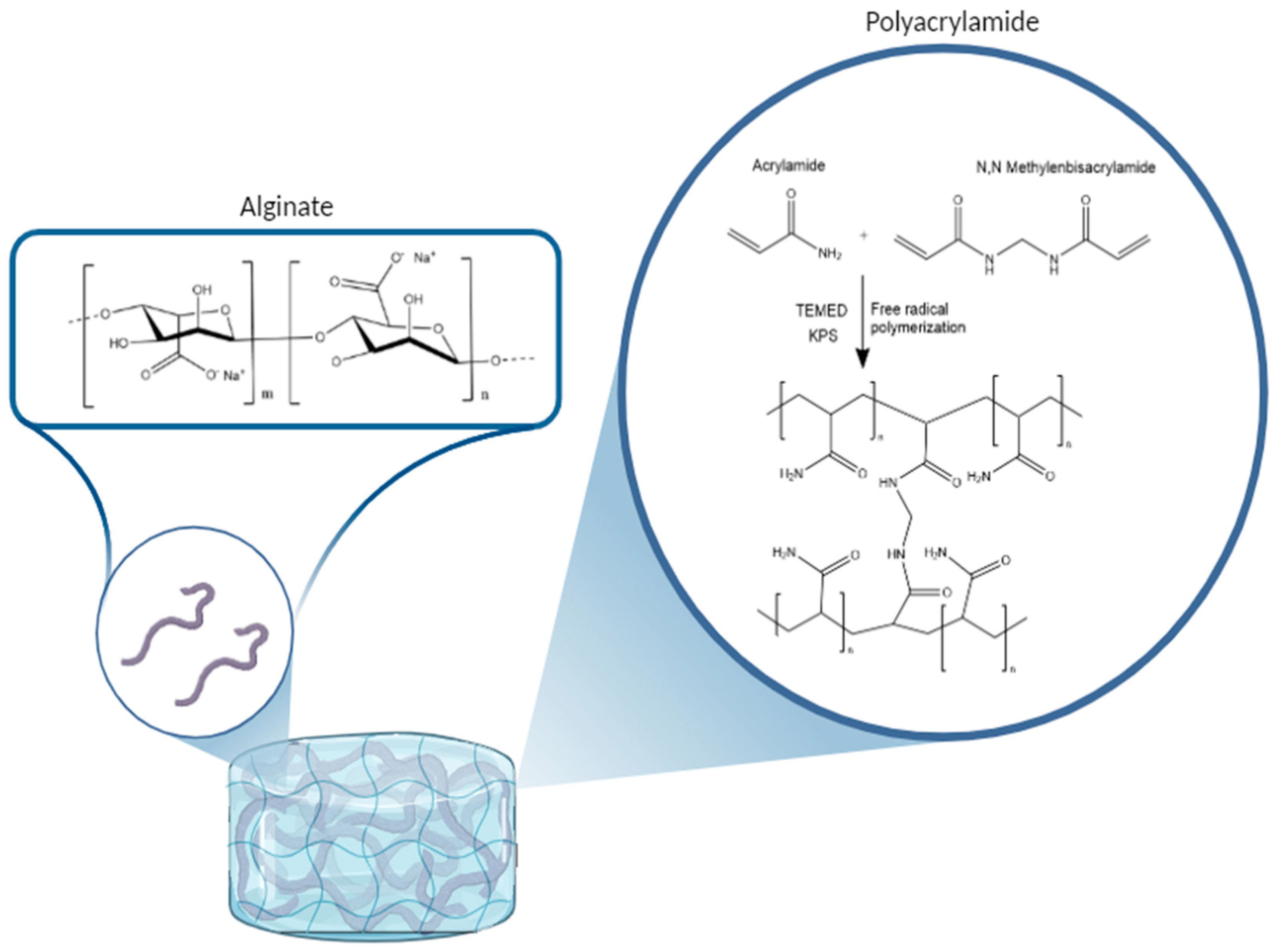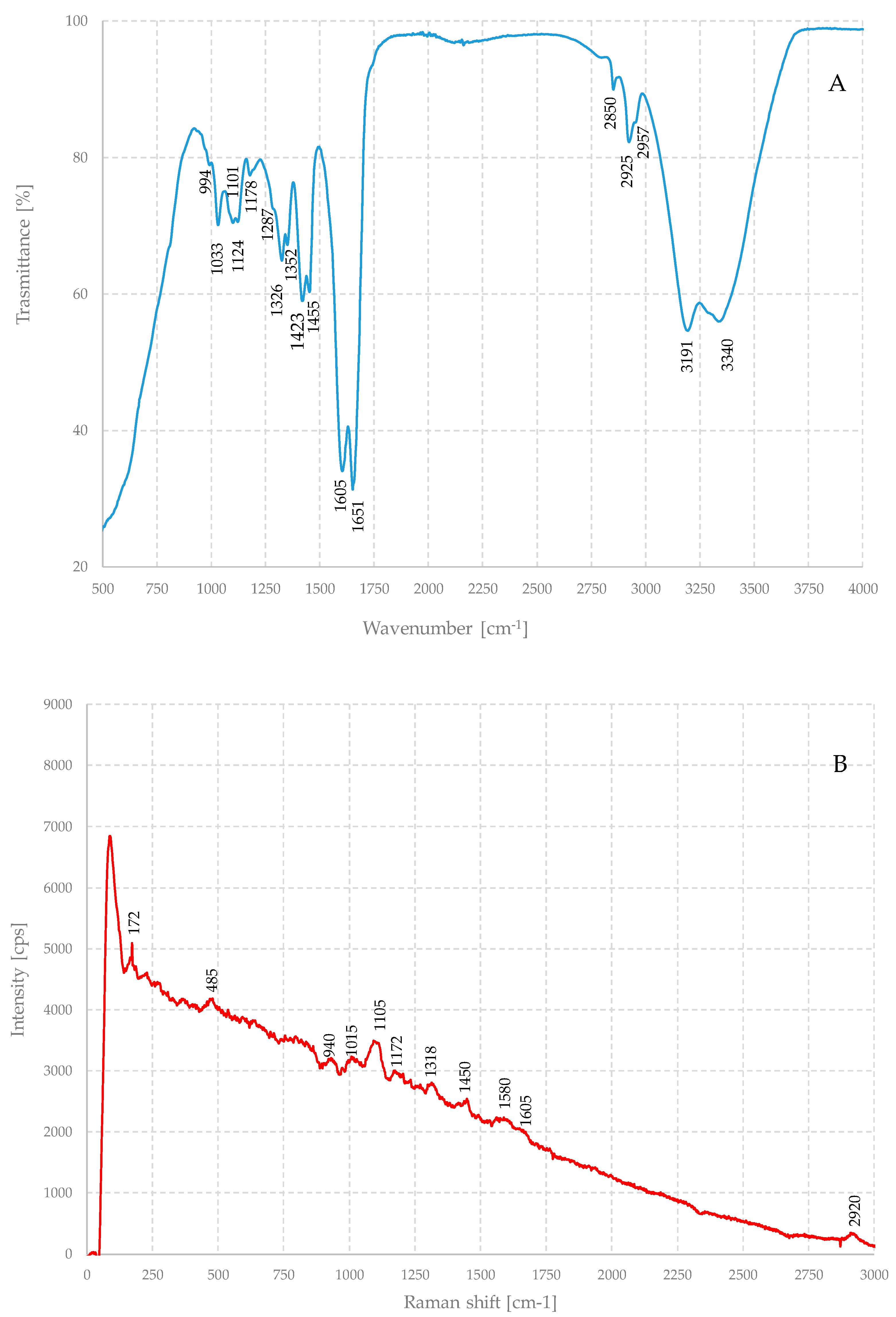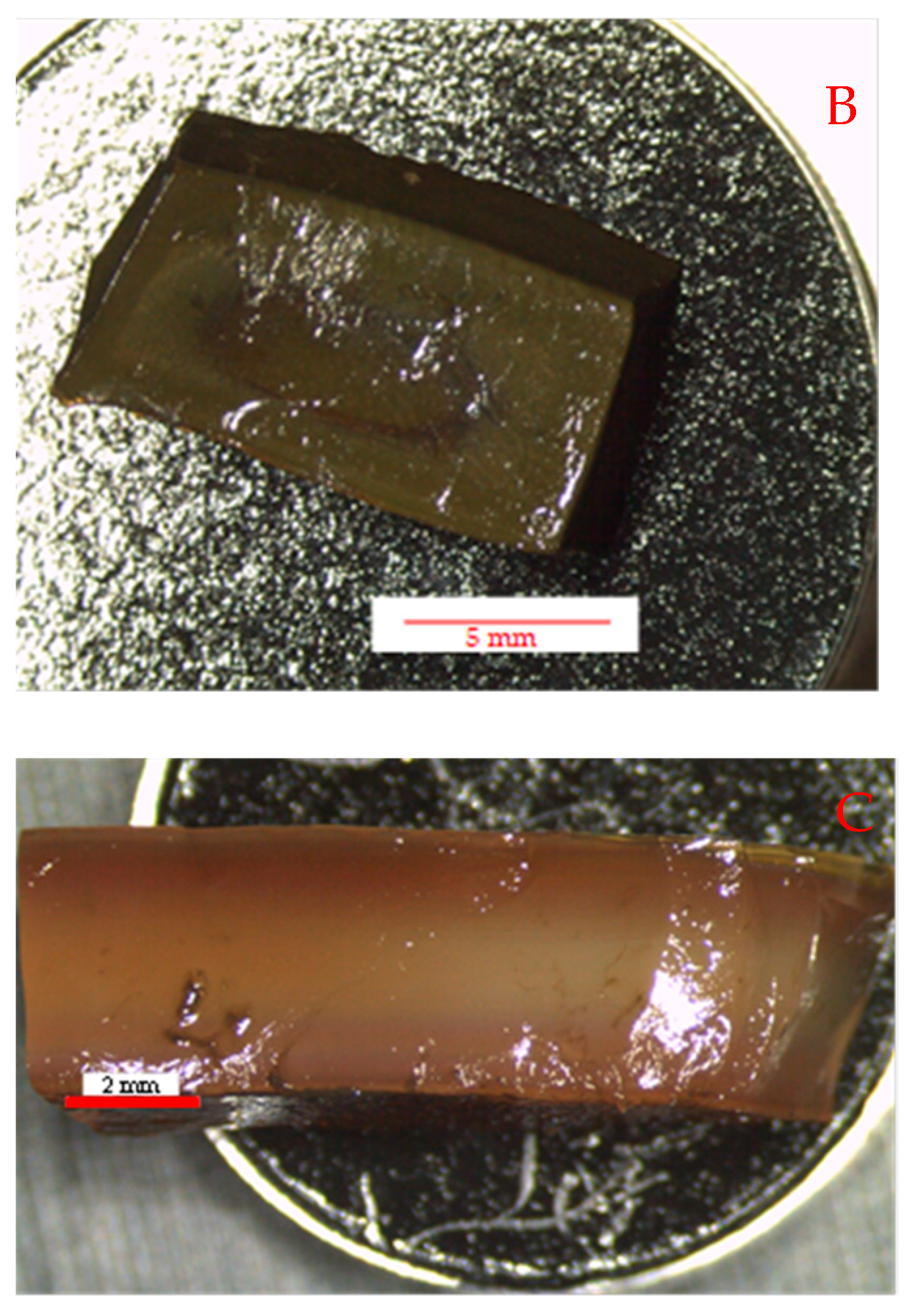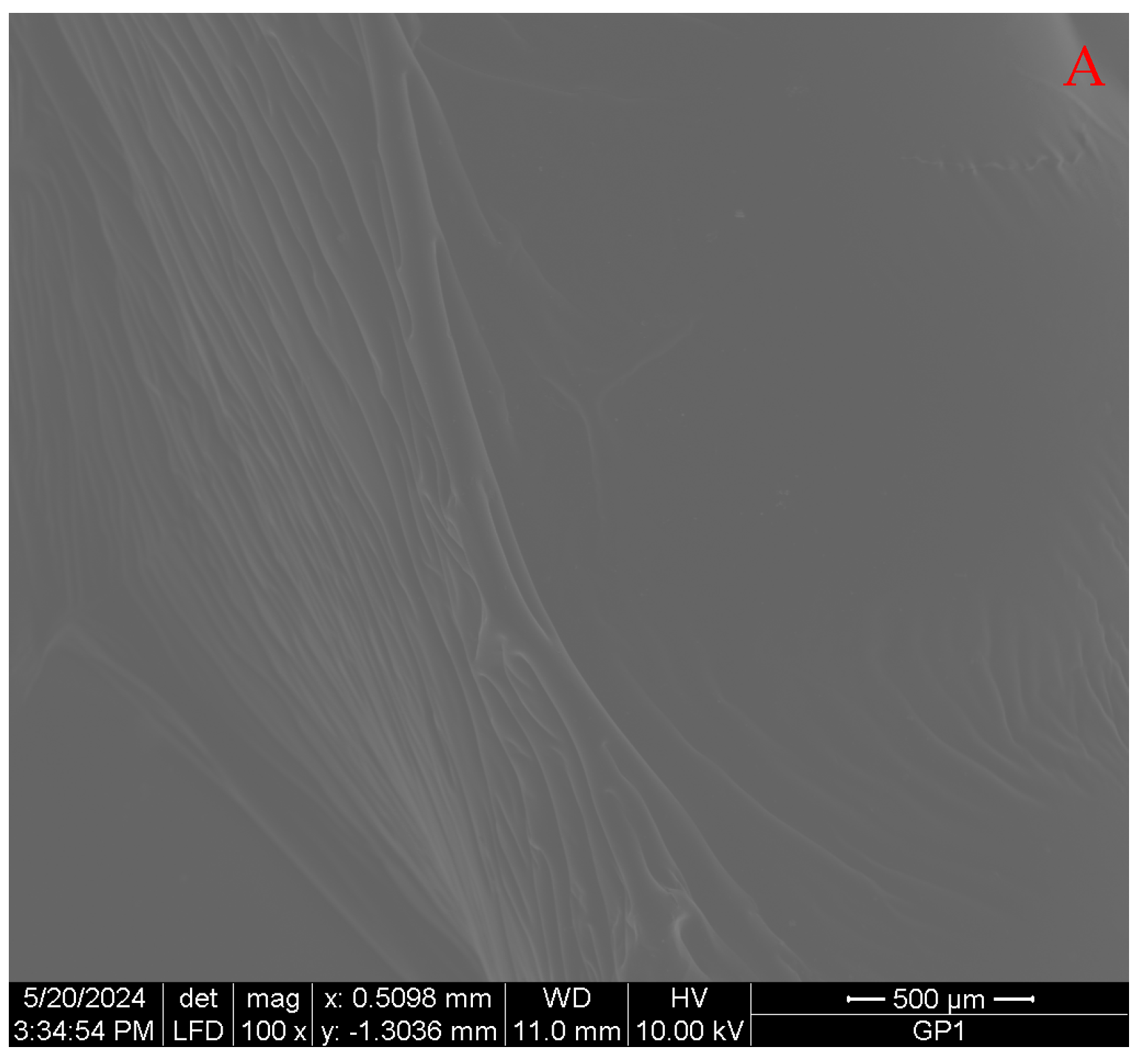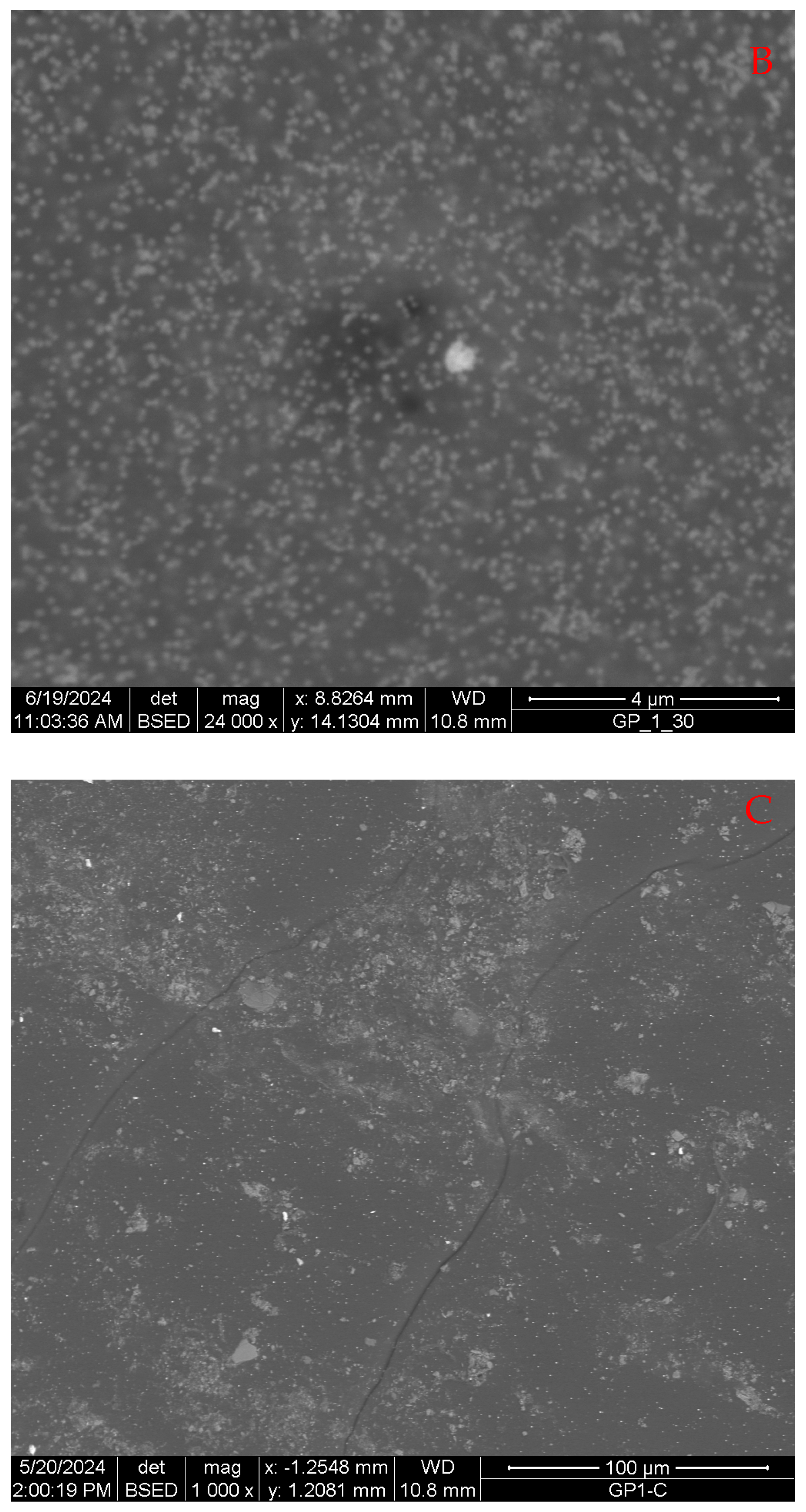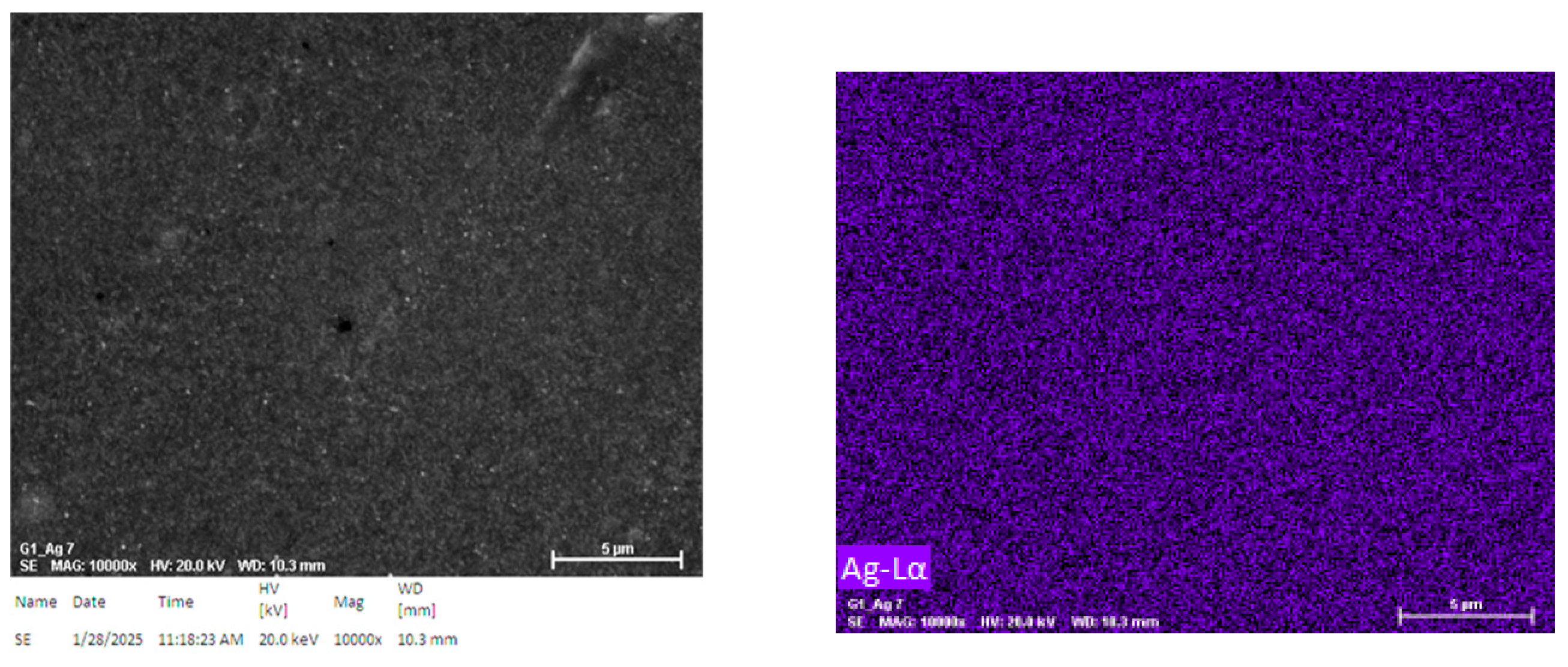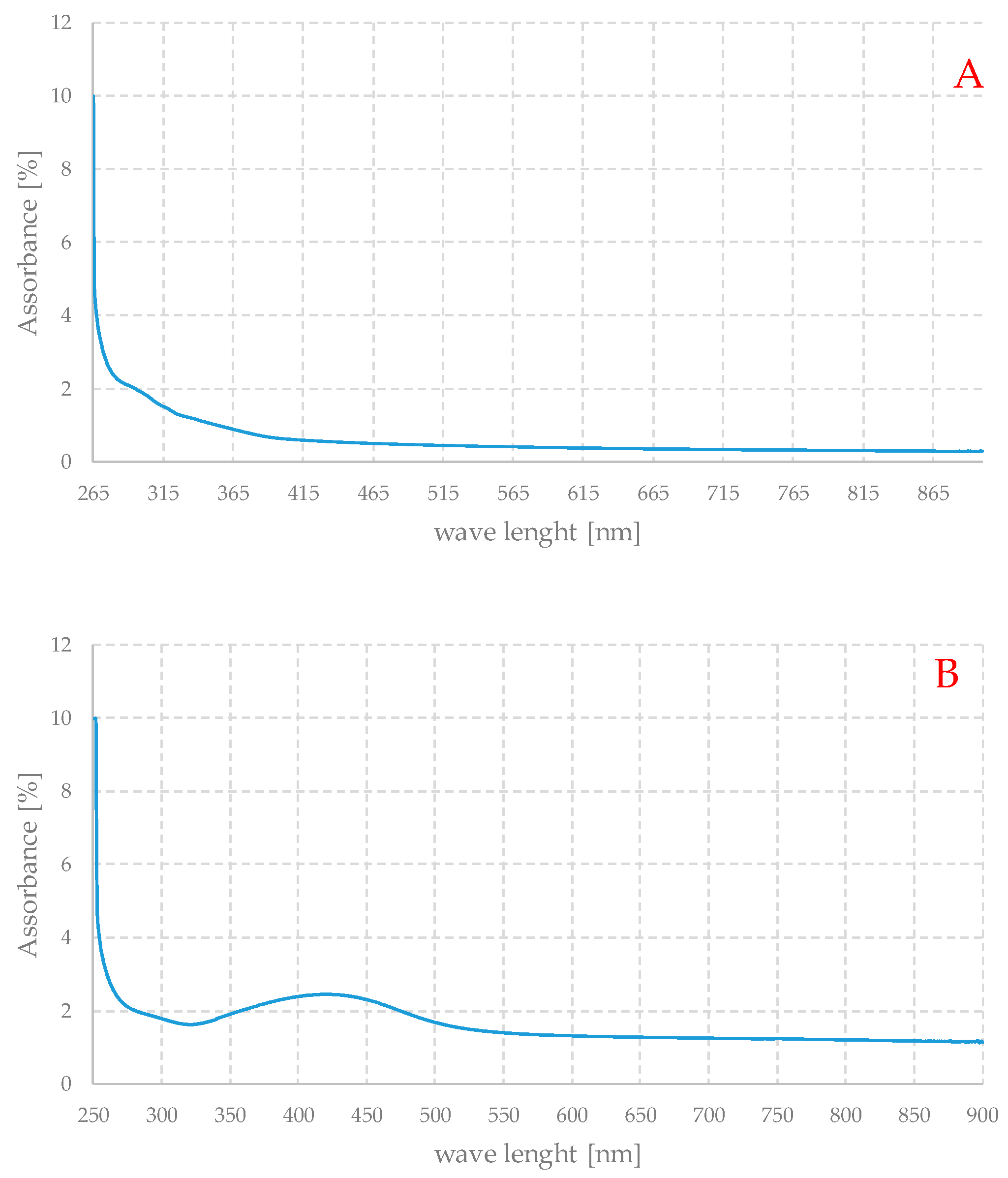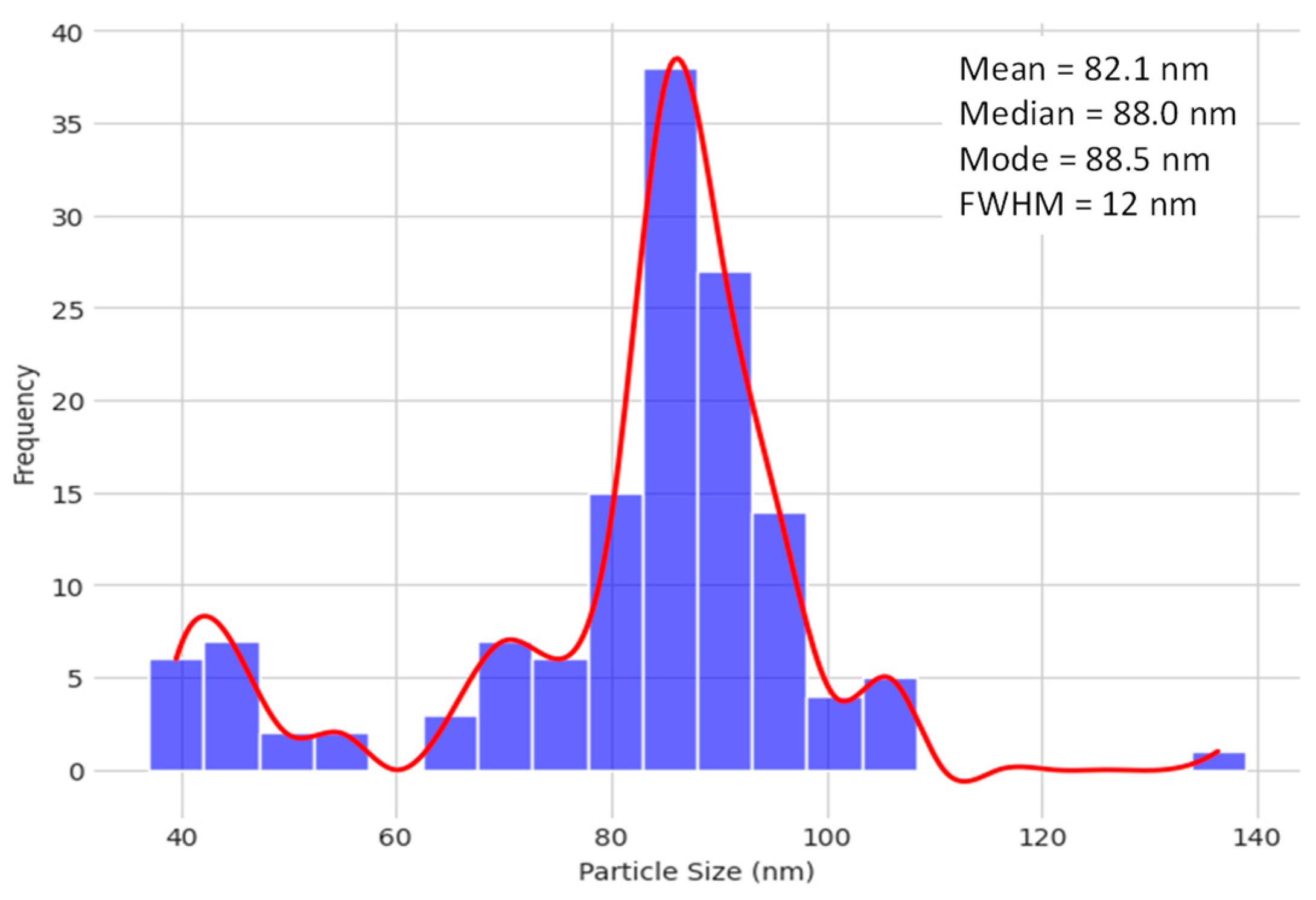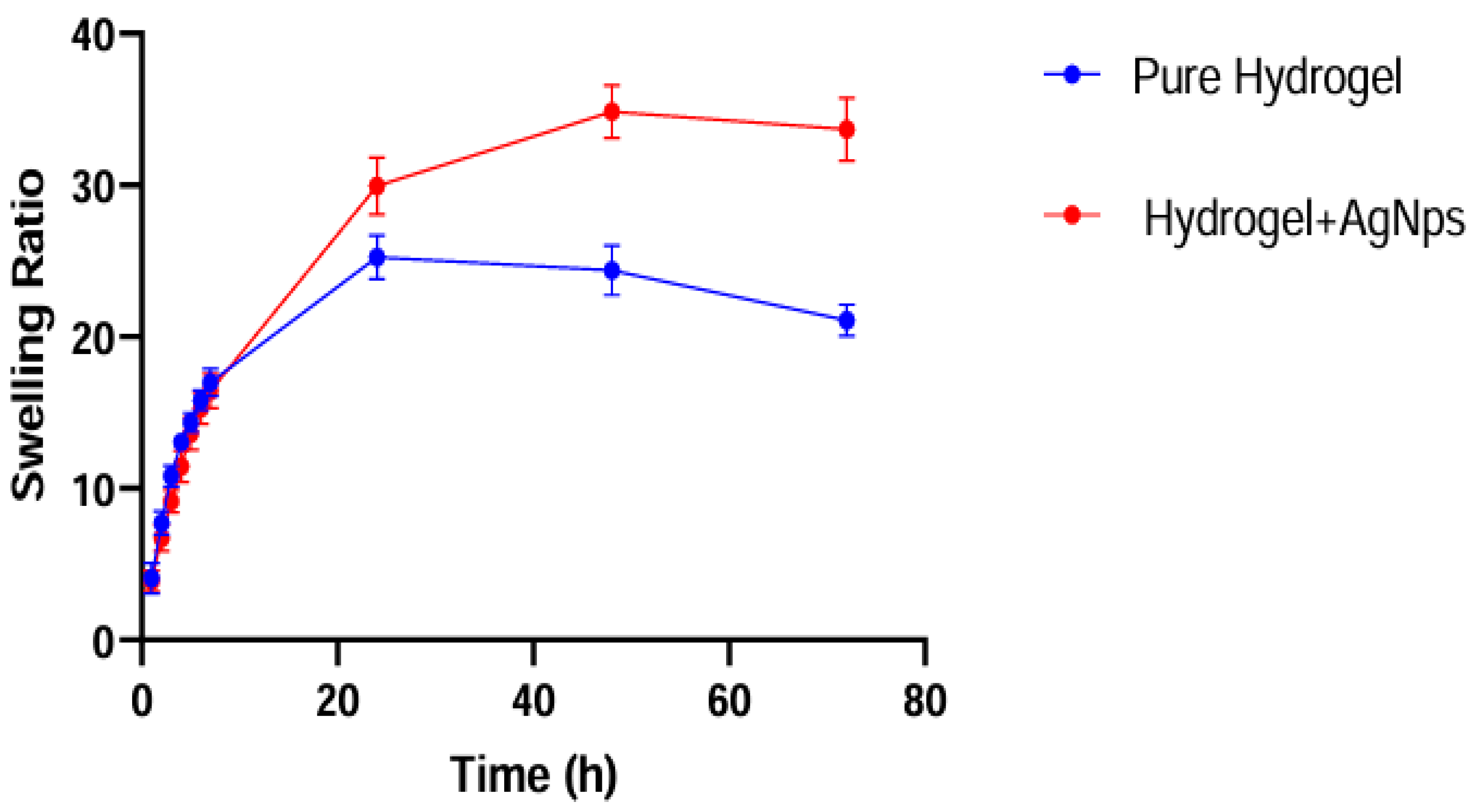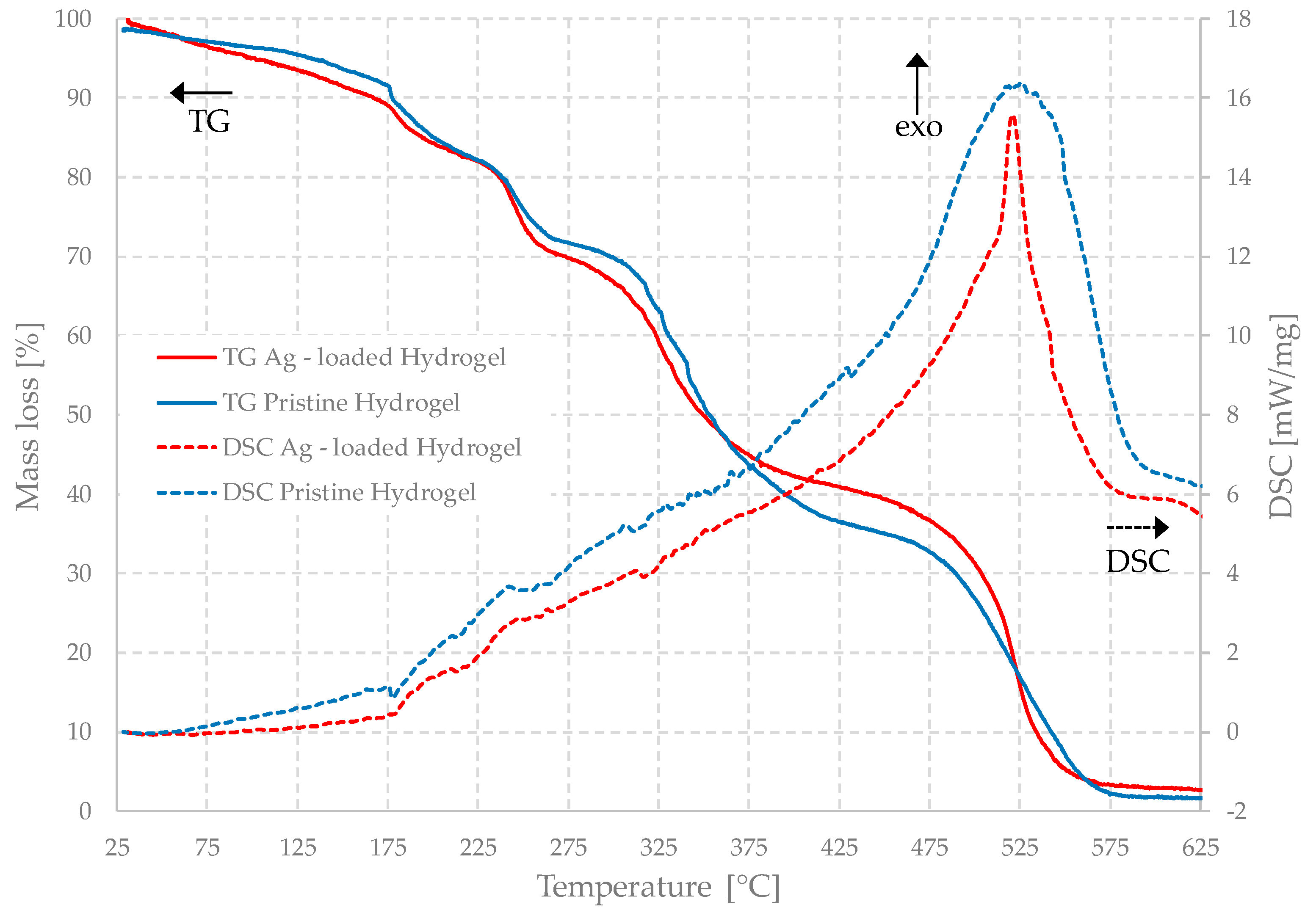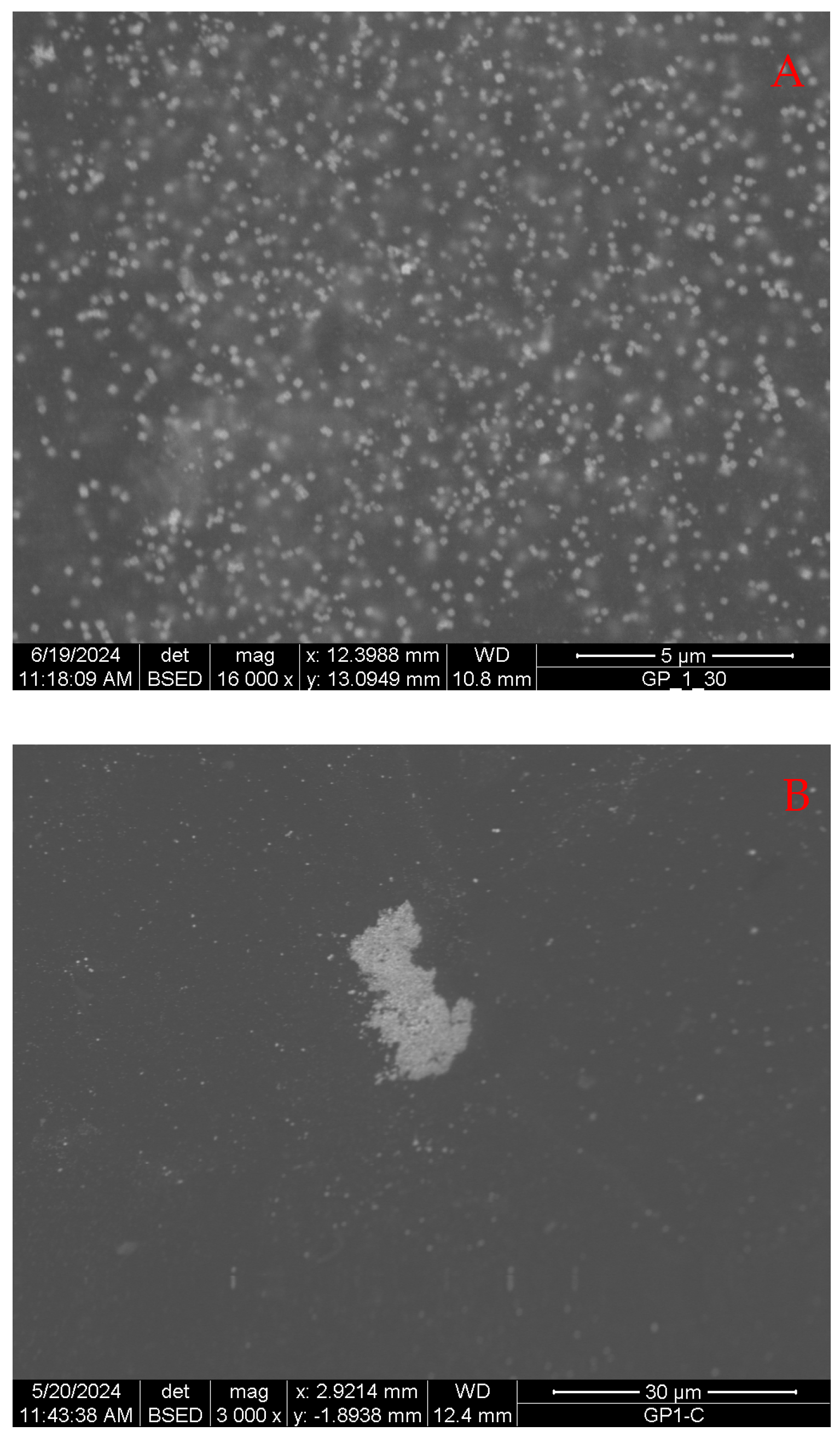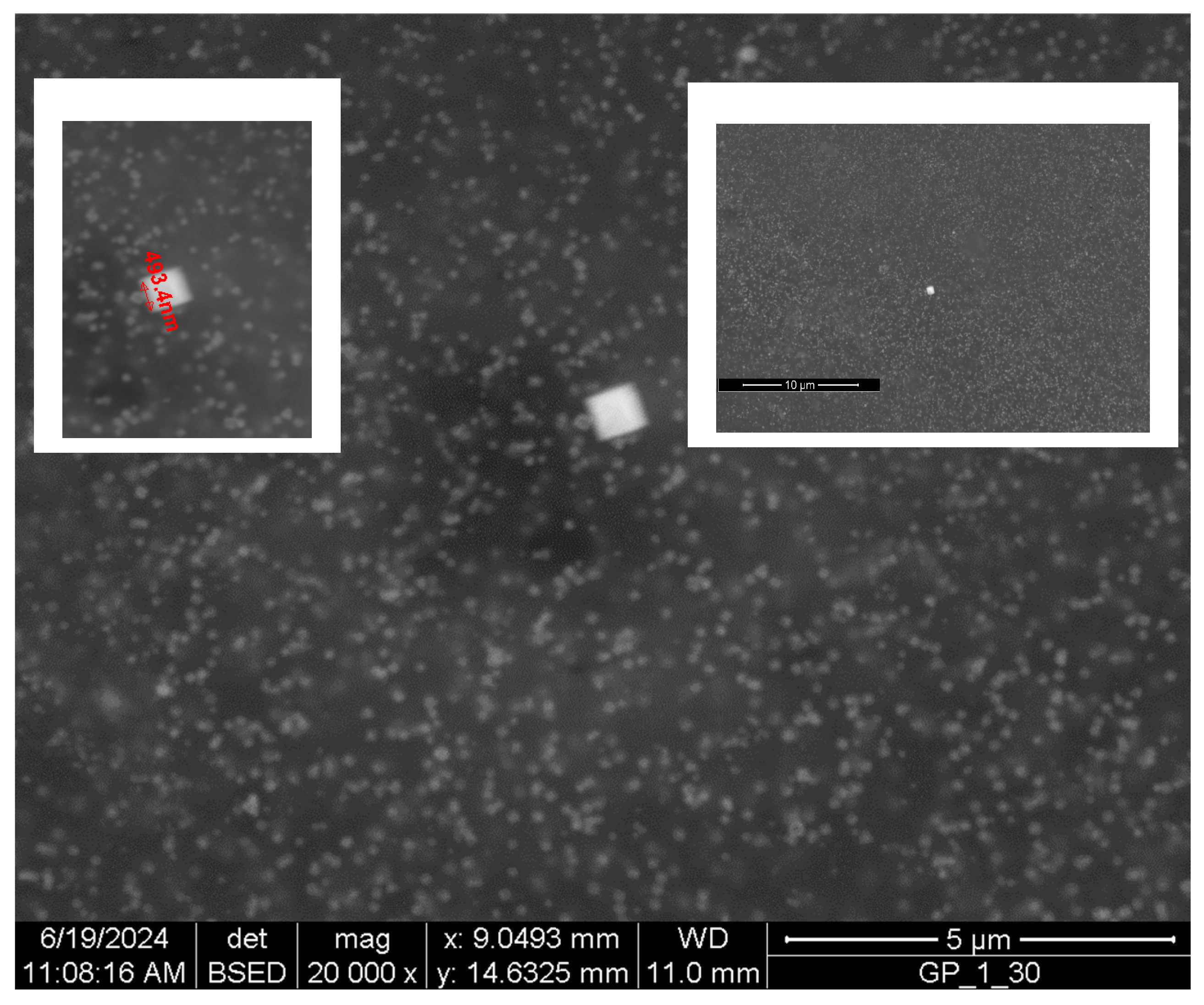3.1. General Characterization
Hybrid hydrogels offer superior physicochemical properties compared to conventional hydrogels, including enhanced mechanical properties, stability, homogeneity, and biocompatibility. Their versatility has garnered significant scientific interest due to their numerous potential applications [
19,
20,
21]. These materials consist of chemically distinct polymer chains linked together through intricate cross-linking, which can be physical, chemical, or due to structural entanglement. A key advantage is their ability to incorporate biologically active polymers, such as polysaccharides, proteins, or peptides, through physical or chemical bonds. The degree of interpenetration between the different building blocks can vary widely, ranging from the molecular level to much larger domains, depending on the size and nature of the constituent polymers.
In this work, an alginate/polyacrylamide composite material was prepared, as these blends can have mechanical properties very similar to several human tissues, such as cartilage, depending on the ratio of the two components. The alginate component provides excellent biocompatibility, while the polyacrylamide network provides the system with high stability and resistance. Depending on the synthesis strategy used, the three-dimensional network is made up of polyacrylamide, while the alginate chains are entangled and intertwined between the meshes.
Sodium alginate is a salt of alginic acid, which in turn is a naturally occurring, edible polysaccharide found in brown algae. This acid is a linear copolymer made by blocks of (1→4)-linked β-D-mannuronate (M) and α-L-guluronate (G) residues, linked together by strong covalent bonds [
22]. Alginate-based hydrogels are widely studied as a common biomaterial for the bio-fabrication of scaffolds and tissue regeneration and for their favorable properties encouraging regeneration, cell proliferation, and mechanical strength [
23].
Figure 2 shows the chemical structure of the sodium alginate molecule.
Sodium alginate is a salt of alginic acid, which in turn is a naturally occurring, edible polysaccharide found in brown algae. This acid is a linear copolymer made by blocks of (1→4)-linked β-D-mannuronate (M) and α-L-guluronate (G) residues, linked together by strong covalent bonds [
22]. Polyacrylamide is a synthetic polymer with the formula (-CH
2CHCONH
2-)
n having a linear chain structure.
Polymerization occurs because MBA can react with acrylic and vinyl monomers, such as acrylonitrile, acrylamide, or similar molecules, by radical pathway, forming cross-linked gels, in the presence of peroxides, REDOX initiators, or ultraviolet light. In this case, KPS, which is also a powerful oxidant, acts as an initiator.
In fact, especially in the presence of TEMED, which catalyzes its decomposition, it originates radicals, according to the reaction:
These radicals, as an initial stage of polymerization, break the double bonds of acrylamide.
Figure 2 shows the chemical structure of alginate and polyacrylamide chains and a schematic of the chemical process leading to cross-linking and then gelation used in this case for the formation of the hydrogel [
24].
The gels thus prepared show excellent uniformity and good mechanical properties, including elasticity, absorption capacity, toughness, and consistency. The homogeneity of these gels is proven by spectroscopic measurements conducted at numerous points of the samples, which result in completely superimposable spectra.
A typical IR spectrum of a gel is shown in
Figure 3A, while
Figure 3B shows the Raman spectrum of the same sample, as prepared, i.e., without nanoparticles.
Vibrational spectroscopic techniques are powerful tools for the non-destructive chemical characterization of samples. Raman and IR techniques provide important information for qualitative and quantitative analysis, and they can be considered from many points of view as complementary. Nevertheless, in both cases, the interpretation of the spectral features of this gel is not trivial, because it is a multicomponent material. Both spectra are the result of the combination of the spectral characteristics of the alginate component and that of the polyacrylamide, although, comparing the spectra with those known in the scientific literature, the latter seems to be the most important component.
The IR spectrum shows as its main feature a broad band between about 3550 cm−1 and 3000 cm−1, which is in the region corresponding to the stretching of the OH, NH, and NH2 groups, as can be expected from a system where hydroxyls and amides are present.
There are two signals at about 3340 cm−1 and 3190 cm−1 that can be associated with the antisymmetric and symmetric stretching of the NH2 groups, respectively. Instead, the hydroxyl peaks are not immediately identifiable but are included in the main band. Other important features are the C-H bonds stretching around 2960, 2925, and 2850 cm−1.
Carbonyl stretching bands fall between 1900 and 1600 cm−1 and, in this range, this sample exhibits two intense and narrow bands at about 1650 cm−1 and at about 1605 cm−1 that can attributed to carbonyl group of amides and carbohydrates.
Below about 1460 cm
−1 there are bands due mainly to the bending modes of NH groups and stretching skeleton vibrations and among C–C–C and C–O–C [
25,
26,
27,
28], but the specific attribution of each band may not be trivial. Finally, below 1000 cm
−1, the fingerprint region begins.
Similar considerations can be made for the Raman spectrum. The main bands of the spectrum can be attributed to the same functional groups. Indeed, it has been reported that, in the first case, the Raman spectra are sensitive to the presence of guluronic and mannuronic acid units [
29]. While guluronic acid units originate a band around 1025 cm
−1, mannuronic acid shows a band at approximately 1100 cm
−1, and their relative abundance determines the ratio between the intensity of these bands. Bands around 1450 and 1170 cm
−1 are associated with the vibrations of polysaccharide backbones, with the symmetric vibration of glycosidic bonds [
30]. In any case, both techniques demonstrated that the polymerization and subsequent gelation occurred successfully and that the samples were extremely uniform and homogeneous.
Nanoparticles are formed because of the oxidation–reduction reaction between silver nitrate and sodium borohydride. The former is commonly used as a starting reagent for the synthesis of nanoparticles, even in complex matrices, and not only in the case of dispersions in water [
31,
32], while the second one is a well-known powerful reducing agent [
33,
34].
Sodium borohydride reacts with protic solvents that release spontaneously hydrogen, but at room temperature, a dilute solution is stable long enough for the process to occur and, in fact, it is commonly used as an efficient reducing agent for silver nanoparticles. The aqueous solution might be less stable at 70 °C, but even in this case, the formation of crystalline particles was observed, so that the reaction also occurs at this temperature.
Formally, the ion BH4- behaves as the hydride ion H- and, therefore, one mole of electrons is available for every 0.5 mole of molecular hydrogen formed by oxidation.
It is possible to write the following redox reactions [
35]:
The method proved to be very effective in the preparation of loaded gels.
Figure 4 shows optical photos of samples cut from an unloaded gel and the top view (B) and section view (C) of samples cut from a loaded gel prepared at room temperature.
The parent gel is, as expected, almost completely transparent, whereas those after absorbing silver nitrate and subsequently reacting with sodium borohydride appear to have a rather dark brown color. On the surface, the samples are very uniform; however, in the section, their central part is lighter, suggesting that there is a lower concentration of particles in the center, although not zero. This means that the reaction front, which moves from the outside towards the center of the samples, can only proceed for a few mm of thickness in the samples, probably less than 2 mm, at least in the experimental conditions discussed in this paper. However, from the point of view of possible applications, especially in the biomedical field and as an antimicrobial system, this may not constitute a real limitation, because only the particles closest to the gel surface can interact with the external environment. In any case, the gels were prepared so as to have a thickness of a few mm, comparable with the diffusion of the reagents inside them and, therefore, it can be assumed that the formation of the particles can occur throughout the thickness of the samples.
Figure 5 shows SEM images of a pure gel (A) and a loaded one, both on the surface and in depth (B and C, respectively).
These images show that both the unloaded and loaded gels are very uniform and they appear very homogeneous and isotropic at the micrometric or even sub-micrometric scale. In the case of the loaded material, an abundance of particles of a size much smaller than a micron is observable. Near the surface, they appear much more numerous than towards the center, which is consistent with the fact that the reaction front proceeds from the outside towards the inside, but their morphology is very similar.
EDS analyses were performed in several areas to determine the composition of these particles. Since they are very small in size, it is impossible to measure their chemical nature and that of the matrix separately; however, the presence of silver is evident.
Figure 6 shows a typical EDX spectrum carried out on a large particle (
Figure 6A) and in a small area (
Figure 6B).
Figure 7 shows an EDS map of the silver distribution in the sample, and it results that its distribution is very uniform and there are no areas where silver is particularly abundant or others where it is absent and no gradient can be observed. Again, since both the average size of the particles and their average distance are very small, it is not possible to directly associate its presence with the individual particles, but it does not seem plausible that it is simply dispersed in the matrix and, on the contrary, this proves that the REDOX reaction has also occurred successfully inside the gel.
The color of the loaded gels strongly depends on the presence and concentration of the nanoparticles. Actually, silver colloids show different colors because of their light absorption and scattering due to plasmonic resonance, which, in turn, depends on the average particle size [
36] and it varies from pale yellow to deep green through orange, red, deep purple, and light blue as, being constant other factors, the particle size increases. The loaded gel is very dark, even almost black, but this can be justified by considering that the color of the dispersions also depends on other factors, including the morphology and concentration of the particles and their synergistic combination and that high concentrations lead to darker colors [
37]. The concentration of particles, as demonstrated by the SEM images, is very high in the samples.
It is possible to characterize silver nanoparticles and determine their main characteristics by UV-Vis spectroscopy. This technique is in fact a well-known and powerful tool for analyzing metal nanoparticles [
38]. It is a simple, and inexpensive technique that provides a non-invasive and fast screening of nanosystems, providing information such as their size, morphology, and aggregation because the spectra are highly sensitive to these factors since the localized surface plasmon resonance of metal nanoparticles allows for a high absorption of photons in the range between about 200 and 900 nm [
39].
However, in this case, the application of this technique is made problematic by the polymer matrix. In fact, by their nature, these polymers could have transitions in the same spectral range as the silver particles, due to the presence of groups, such as carbonyls and double bonds, which can absorb UV photons. Since nanoparticles constitute a very small fraction of the samples both by mass and volume, their contribution may be very small and difficult to recognize. On the other hand, it is not possible to remove the matrix, either thermally or chemically, without the risk of altering or modifying the particles. Furthermore, it would be difficult to completely catch (e.g., by filtering or sieving) such small objects without important losses, above all of the smallest fractions.
For these reasons, it was decided to perform the UV absorption analyses on the loaded gel sample completely dried and reduced to powder and then dispersed in water in a ratio of approximately 1:10. For comparison, the pure gel sample, without particles, was also treated and analyzed in the same way. It is interesting to note that the gel powders quickly reabsorb water and create a uniform mass directly inside the sample holder with simple manual stirring.
In addition, the residual liquid obtained after the absorption stage of the sodium borohydride solution by the gel was also analyzed. At the end of this step, this liquid appears slightly brown in color, suggesting that some particles have escaped from the gel.
Figure 8 shows the UV-Vis spectra of the parent gel in the form of a dispersion in water (A), of the loaded gel, analogously dispersed in water (B), and the residual liquid with nanoparticles (C).
The spectra thus obtained should be understood as qualitative, because some important factors such as concentration are not known. Nevertheless, Figures B and C show the typical appearance of the UV spectra of silver nanoparticle-based systems. Spectrum A shows a strong absorption below about 250 nm, which evidently corresponds to the electronic transitions of the organic component of the material. Spectrum B is very similar to the previous one, with the same type of absorption at high energies, but a peak centered at about 420 nm is also evident, while in spectrum C, since the organic component is absent, this absorption signal is not present, but only a peak in the same range as in the case of the loaded gel. The maximum is at slightly shorter wavelengths, but the two curves are generally quite similar. The spectrum of the loaded gel exhibits a non-zero absorbance, but practically independent of the wavelength between 550 and 900 nm. This can be due to the weak absorption of the organic part of the material and to the scattering of light due to the particles themselves. This can also account for the very dark color of these gels.
In general, the peak position is strictly dependent on the average particle size, and the maximum centered between 400 and 450 nm is associated with particles of about 80–90 nm in size [
38,
40], a value that seems quite compatible with the SEM observations.
From the image analysis, in fact, it is possible to establish the dispersion curves of the particle size and evaluate their widths and other characteristics.
Figure 9 shows the histogram of the particle size distribution curve.
This method should be seen as indicative rather than exactly correct. Furthermore, this technique can overestimate the fraction of small particles. In fact, some particles can appear smaller than they actually are, if they are “deeper” in the gel than the observation plane. Despite this, the curve is quite narrow, although slightly asymmetric, with a full width at half maximum (FWHM) of around 10–15 nm. The peak of the curve is centered at around 82 nm.
To gain further insight into the nature of the particles and to gain structural information on the gels, they were also analyzed by XRD diffraction. The XRD analysis of the samples was performed both on the gel with no particles and on the loaded ones, in both cases for both hydrated and completely dehydrated samples, to investigate the crystallinity of these particles and to verify if they induce any changes in the polymer matrix. In the case of the hydrated samples, two pieces were cut to fit the available space in the sample holder, while the dry samples were carefully ground and pulverized before analysis.
Figure 10 shows XRD patterns: the parent gel (A) hydrated and dehydrated and an equally hydrated and dehydrated loaded gel (B), prepared at room temperature.
Taking these measurements for this type of material requires special care and attention, due to the intrinsic nature of the samples. X-ray diffraction is very useful in the case of crystalline samples, but gels are basically amorphous and the amount of nanoparticles, in terms of mass and volume, is very small, meaning that their contribution to the total XRD pattern is also very weak. This contribution can be even more meaningless for a hydrated gel, because the large water content makes the ratio between the mass of the nanoparticles and the total mass of the samples even smaller.
There are also technical issues to be addressed. Most diffractometers require that the sample to be analyzed lies on a precise plane to avoid geometric and systematic errors in the position of the diffraction peaks. For this reason, the sample holder must be filled carefully, avoiding that the surface of the sample is below or above this ideal plane, but coincides with it. In the case of gels, this is not easy to achieve because it is necessary to cut pieces of the correct shape and size from the sample. The samples are also very elastic and partially sticky, especially the loaded ones. While, for pure gels, this represents a relative problem, because they lack precise structural characteristics, in the case of loaded materials, however, an imperfect positioning of the sample to be analyzed could lead to a non-negligible shift of any eventual peaks, making identification difficult. Nevertheless, the results of these analyses can be interesting.
The patterns are quite similar to each other, especially those of hydrated gels, and they are very noisy and weak, as usually found in the literature for these materials.
Polymers can be semicrystalline and exhibit some peaks in their diffractograms due to the possible presence of ordered domains, such as lamellae, sheets, spherulites, or other structures. However, it is more difficult to observe these structures in gels or in general in cross-linked polymers, because the pieces of chain between two successive cross-linking points are shorter and the cross-linking points constrain the movement of the individual units or chains. Cross-linking decreases the possibility of the ordered packing and, on the contrary, favors the presence of large amorphous areas.
The XRD of the parent hydrated gel is characterized by a very broad, intense peak, approximately between a 2θ angle of about 25° and 40°, so that its maximum lies at a 2θ angle of about 30°. The spectrum then shows a second very broad peak with a maximum at about 42°. The intensity of the maximum is approximately two-thirds of that of the main peak, so that the second peak appears as a sort of shoulder of the first. The diffractogram of the dehydrated gel is very similar, but the first peak shifts to much smaller angles and the maximum is located at about 22°. The second signal, on the other hand, does not change its position much, staying at about 40°.
It is difficult to justify the presence of these humps in the spectrum, which may indicate the presence of modest local ordered arrangements. However, it should be kept in mind that, for this material, there are two sublattices to consider, one due to the polyacrylamide and the other due to the alginate, and each might provide a different contribution. In any case, it appears that the sample is very homogeneous on a large scale.
A similar situation can be observed in loaded hydrated gels. However, the first peak appears much narrower and the second less intense. The first maximum shifts to slightly lower angles, while the second one does not change its position. In the diffractogram of the loaded gel, additional bands also appear, a rather narrow one between the two main ones and a very wide one centered at around 2θ = 60°, which are not immediately recognizable in the parent gel. This could suggest that the presence of the particles perturbs, at least locally, the structure of the gel and could even induce slightly more ordered areas.
The XRD pattern of the dehydrated sample is very different from the others. Also, in this case, there is a component in the diffractogram due to the amorphous matrix and, as in the case of the pure gel, the absence of water causes the humps to shift to smaller angles, but the main feature is the presence of some quite wide peaks. Evidently, the absence of water increases the ratio of the mass of the particles to the rest of the matrix so that their signals are recognizable. These peaks can be readily assigned to metallic silver as well as sodium nitrate (NaNO3), which forms as an additional product in the oxidation–reduction reaction. It is a very soluble salt and, therefore, in any case, not detectable in the hydrated gel, but when the water is removed, it too is forced to crystallize inside the gel. Silver peaks may also be present in the hydrated sample, but they are so weak that they are confused with the noise of the curve.
It is not trivial to understand how nanoparticles induce structural change in gels and what effects they have on polymer meshes and, thus, how the diffractograms change because of their presence. In crystalline materials, it is well known that the XRD peaks of isostructural systems shift towards respectively smaller or larger angles if their crystal cell expands or compresses due, for example, to chemical substitution or the application of an external pressure. This behavior is obviously not immediately transferable to amorphous materials because the shifting of the peaks is due to the change in distances among the lattice planes, which are obviously absent, but it could be imagined something similar in this case too.
Hydrated gels have stretched polymer chains, leading to more coherent diffraction and, thus, diffraction peaks at smaller angles. Dehydrated gels have collapsed, twisted chains, resulting in less coherent diffraction. While gels are amorphous, they still exhibit diffraction peaks due to local order. Just as crystal lattice changes shift XRD peaks in crystalline materials, changes in gel polymer chain extension (due to hydration) can similarly affect the position of diffraction peaks/bumps, shifting them to smaller angles when the chains are more stretched (hydrated) and larger angles when the chains are collapsed (dehydrated).
Nanoparticles can be expected to force the chains to stretch further, just for a steric effect, so that the signals in the diffractograms shift towards lower angles. They can also change the amount of water present in the gel and, actually, the swelling of the loaded gels is much higher, as will be shown shortly, which can certainly cause the polymer meshes to expand considerably.
The swelling behavior is shown in
Figure 11: The gels were first completely dehydrated, leaving them in an oven at 40 °C for at least one week, and then immersed in distilled water to allow them to reabsorb it. Samples of approximately 0.1/0.2 g 1 cm × 1 cm were immersed in 40 mL of distilled water, changing it every time, and weighed after fixed intervals.
Swelling, S
m, can be defined as:
where S
m is the mass variation associated to swelling, and m
f and m
0 (i.e., the mass of gel in its dehydrated state) are the final and initial masses, respectively. To reduce the experimental error, which may be due, among other things, to the difficulty of handling these samples (for example, gels may lose mass during the removal of excess water or on the contrary water may remain attached to their surface), the value was averaged over the weight variation in at least ten samples.
Both kinds of gels show a very high capacity to absorb water, as the swelling ratio after 24 is about 25 and 30 for the unloaded and loaded gel, respectively. Since the matrix is the same, the gels have a similar behavior and comparable absorption rate and statistically behave in the same way; however, the water absorption capacity is much higher for the silver-loaded gel than the parent gel.
The nanoparticles also have effects on the thermal properties of the gels, as can be observed in
Figure 12, which shows the DSC-TG curves of different dehydrated samples.
These hydrogels also show great thermal stability. It is worth noting that the gel is stable up to about 150 °C, with a small loss of mass associated with the evaporation of residual water and, again, the Ag-loaded gel confirms its higher capability of absorbing water since the small residue is released more slowly and at slightly higher temperatures than the one without nanoparticles. The last step is the most exothermic one and indicates that the complete degradation of the gels, in all the cases, occurs no earlier than 400 °C, with the peak at approximately 525 °C, and it is complete at about 580 °C. The samples decompose practically completely, turning into volatile compounds, such as CO2, and leaving a very small quantity of solid residues and ash. The overall mass loss of the loaded sample is slightly smaller, less than 1%, which is likely due to the metallic silver residues. Between 200 °C and 400 °C, some exothermic degradation reactions occur, to which smaller mass losses are associated.
Both the DSC and TG curves of the unloaded and loaded gels are very similar. The temperatures at which the transformations and mass losses occur are practically identical below about 350 °C. The filled sample loses slightly more mass between room temperature and 200 °C, which is consistent with the possible higher presence of water in it and with the differences observed in the diffractograms. Furthermore, this means that these transformations are due to the polymer matrix alone.
At higher temperatures, some differences are observable. The TG curves diverge at this temperature and, in the range between 400 °C and 500 °C, the parent gel shows a slightly higher mass loss. For the loaded gels, in fact, the mass is nearly constant for about 50 °C, between 400 °C and 450 °C, and then it changes more abruptly. Above about 520 °C, the difference among the curves decreases, and the final plateau occurs at an almost identical value. The most significant difference is in the DSC curves, because they are completely coincident between room temperature and approximately 450 °C, but the main peak has a very different shape in the two cases.
In the case of the loaded gel, the peak is much sharper than that in the other system, in which it has a more rounded shape. However, the temperature at which the maximum occurs is, in fact, the same, and the starting and ending temperatures are almost identical. This indicates that all transformations are, therefore, due to the polymeric component, but that silver nanoparticles have a rather surprising stabilizing effect on the matrix, which becomes more resistant to the temperature increase. The very broad DSC peak observed in the pristine gel may indicate that, as the degradation proceeds, chains with different molecular weights are formed, each with a slightly different thermal behavior, while this phenomenon is inhibited or at least reduced in the case of the loaded gel. This behavior is not uncommon in nanocomposites [
41,
42]. It can be related to the presence of many functional groups, often hydrophilic, present on the polymer chains, which can have chemical and electrostatic favorable interactions with the surface of the nanoparticles. These interactions, on the one hand, make the dispersion of nanoparticles inside the gels more stable and, on the other hand, it makes the matrix more resistant.
3.2. Microscopic Characterization
Silver nanoparticles can have very different morphologies and crystalline habits, depending on the conditions under which they are synthesized [
43,
44,
45]. They can be present as quasi-spherical, cubic, octahedral, planar triangular, rods, and of many other shapes. This is often due to the nature of the reducing agent, the presence of activators, capping and dispersing agents, and the experimental conditions. All these factors can direct the formation of one type of nanoparticle at the expense of others, regulating their kinetics.
However, in the case of their growth inside a matrix, i.e., in a situation that is different from the free formation of the particles in an aqueous medium, the diffusion rate of the reacting phases and their concentration must also be taken into consideration.
Figure 13A shows the average appearance of a gel in which the particle formation reaction at room temperature occurs. It is possible to notice a very high number of particles of very uniform size, in the range of 80–120 nm, which is consistent with the average size of silver nanoparticles that can be obtained by controlled reduction using sodium borohydride. In fact, when prepared in aqueous media, using this reducing agent, the nanoparticles have a size ranging from 50 up to 140 nm, depending on the experimental conditions [
46].
Some particles appear to have sharper edges than others, which on the contrary appear to be more blurred, but this may be due to the fact that the latter are deeper in the gel matrix than the observation plane and, therefore, are reached and reflect a smaller quantity of electrons. These particles appear as squares in most cases. Since, in this case, it is not possible to observe the free particles, but they are seen along a plane, which is the surface of the gel, what is observed is, therefore, a two-dimensional view of three-dimensional objects. The square appearance is very compatible with particles with an octahedral habit, although the cubic one cannot be completely ruled out. The average distance between them is comparable to their average size, and it can therefore be said that this distance is in the range between one time and twice the size of the particles. However, in the same sample, there are some rare areas where there are aggregates of particles that are not uniform (
Figure 13B). Although, in these areas, the particles are on average closer together, their appearance and morphology are still very similar to those of the others.
These types of aggregates are quite rare in the observed samples, suggesting that their origin is peculiar. It is worth noting that the area around them is rather poor in other isolated particles and that, therefore, the gel is somehow depleted. Probably, these areas form inside of macroscopic defects of the gel, where a certain amount of reacting solutions accumulate, removing it from its immediate surroundings.
In this sample, there are few crystals, with a size much larger than the average size of the other particles, as can be seen in
Figure 14: the left insert allows to evaluate the size of this crystal. These large particles are extremely rare, as can be seen in the right insert of the same image that shows its surroundings at a larger scale. No other large crystals are evident, even at great distances, meaning that there are only a few of them for every thousand or tens of thousands of standard-sized nanoparticles.
This larger particle resembles, although its chemical–physical origin is very different, what is sometimes observed in sintered materials in the case of exaggerated grain growth [
47,
48]. In this case, some grains become tens or hundreds of times larger than the average size of the others, and this behavior is normally associated with an extremely high-growth kinetics, which in turn is due to the presence of liquid or mobile phases in the microstructure of these sintered bodies. It is difficult to offer an explanation regarding the origin of this nanocrystal inside the gel matrix; however, it seems plausible that, also in this case, the growth kinetics was much greater than that of the other particles, which in accordance with their narrow size distribution curve. The kinetics of formation of these particles must be very constant and they all appear at the same time; otherwise, the distribution curve would be wider and, next to a few large ones, there would be other very small ones. The largest particles would be the first to have formed and, therefore, would have had more available time to grow.
On the contrary, this crystal seems to be the only one much larger than average, and this means that it formed with a higher growth kinetics than the other particles. There may be a few explanations for this behavior. For instance, this is due to an initial fluctuation in the concentrations of reagent solutions, or some residues of the substances used to make polymerization and gelation occur could have had a catalytic action for growth, acting as a heterogeneous nucleation center. Another possibility is that this is due to some local defect of the gel at the microscopic scale, such as, for example, a region where, for random reasons, the cross-linking is lower than its average value. The crystal, thus, would have formed in an area with more free space available.
It has an almost perfect square shape. The same reasoning proposed previously can be extended to it: What is observed is the planar section of a three-dimensional object. It could therefore be cubic if observed face on, or it could be octahedral if observed with one vertex towards the line of sight. The second possibility seems more correct because the square looks to be formed by four triangles joined at the center. The morphology of this crystal is not different from that of the smaller particles, and this suggests that their shape depends on the fact that they form inside a gel matrix and not freely in a liquid medium. The interactions between the growing particles and the matrix must therefore play a very important role.
Figure 15 shows the typical appearance of particles formed at 5 °C in 24 h (A), at 50 °C (B), and that of particles formed at the same time at 70 °C (C).
All samples are still very homogeneous, in the sense that they also show a uniform distribution of similar particles without any particular and evident spatial gradients, but they are also quite different from each other. The samples prepared at the two lowest temperatures are very similar to each other, while the one made at 70 °C is mainly made up of a few large particles, some of which are larger than 200 nm. At this temperature, most of the particles have an octahedral shape; however, other particles with an irregular appearance are also present. It seems that these particles are an aggregation of other smaller ones. At this temperature, moreover, the particle distribution curve is somewhat broader than that at lower temperatures. In all the cases, some agglomerates of particles are present, approximately with the same frequency. This seems to confirm that they form where the gel tissue presents irregularities or defects. In the sample prepared at 5 °C, very large nanocrystals were not detected, which instead become more frequent at 50 °C and common in the sample prepared at 70 °C, meaning that their presence depends on the temperature. The main difference between these samples is that, in the samples prepared below 30 °C, there are a very large number of particles around 80 nm, while in the one prepared at 70 °C, there are few particles, all much larger. The sample prepared at 50 °C appears to be intermediate between these two situations and in this case two distinct populations of nanoparticles coexist. Here, small-sized nanoparticles are present and are the most abundant group, although they are not as common as at lower temperatures, while many larger-sized particles appear, but not as common as at 70 °C. It is interesting to note that there are virtually no particles of intermediate size between these two populations, and this suggests that it is very likely that the larger particles are not formed as a result of evolution and growth from small ones due to ripening or coarsening phenomena, but rather that both groups are formed independently at the beginning of the reaction and that, once formed, the particles do not change either shape or size. The decrease in the number of particles as the temperature increases is consistent with the increase in their average size, because it must be kept in mind that the initial amount of available silver was the same in all samples. In fact, one can imagine that a few large particles have a total mass equal to that of numerous small particles and, therefore, the number of particles and their size are inversely proportional.

